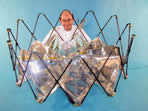Sergio Pellegrino's deployable structures have hit the headlines again - this time in American Scientist (March-April issue, 2004).

In a five-page article, the author, Henry Petroski not only explains the principles of deployable structures with considerable clarity, but also describes his visit to the Deployable Structures Laboratory in Cambridge last summer, where he was hosted, to his obvious delight by Professor Chris Calladine.
Petroski's descriptions of the wonders he found, from models with the 'beauty of form and operation of a flowering plant' to 'skeleton-like assemblages of wires in tension and struts in compression', makes for excellent reading, whilst his description of the ubiquitous use of deployable structures in our everyday lives from retractable clothes lines to reclining chairs shows how indebted we are to this engineering discipline. In particular, the work of Dr Keith Seffen features prominently: he uses hinges cut from a retractable steel tape measure to form a mechanism that can be used to deploy panels remotely in space. This research is used to great effect in the article to explain what deployable structures are, and how they work.
'Deployable Structures' by Henry Petroski, American Scientist, March-April, 2004, Volume 92, p122-126.

